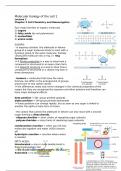Summary
Samenvatting H2 en H3 Molecular Biology of the Cell (Seventh Edition) - Molecular Biology of the Cell 1 (WBFA006-04)
- Module
- Institution
- Book
Four major families of organic molecules: sugars, fatty acids, nucleotides, amino acids. About their function, structure, etc. Noncovelent bonds and how strong they are/ weak. Proteins: structures (and alpha helix and beta sheets), bonds, amino acids, 4 views, domain + domain shuffling, dimer, tetr...
[Show more]




